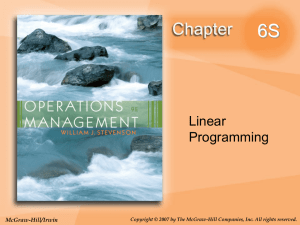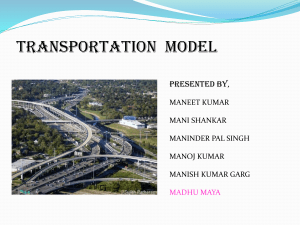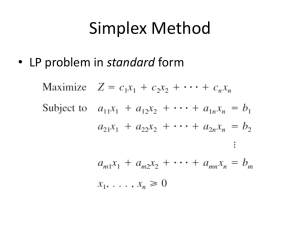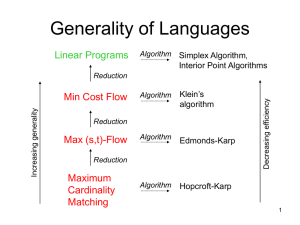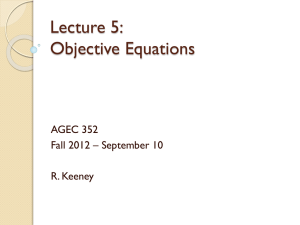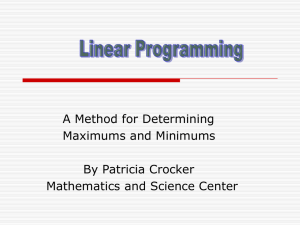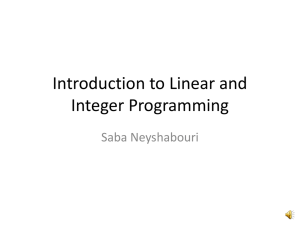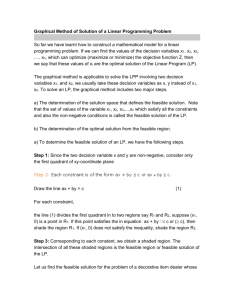Linear Optimization
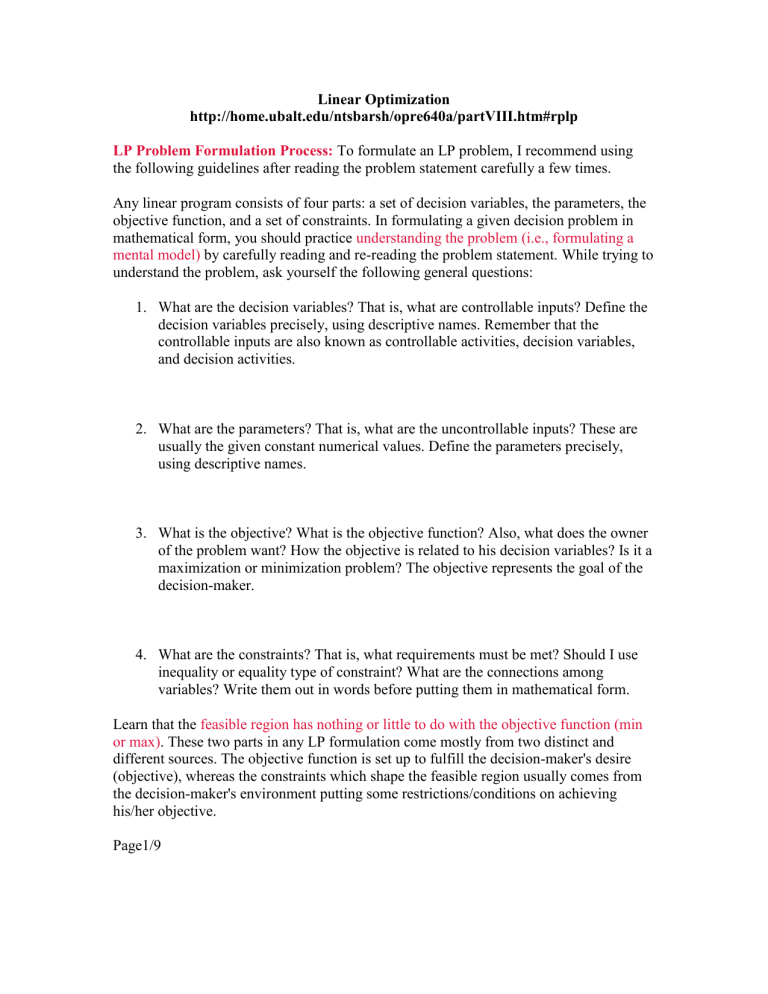
Linear Optimization http://home.ubalt.edu/ntsbarsh/opre640a/partVIII.htm#rplp
LP Problem Formulation Process: To formulate an LP problem, I recommend using the following guidelines after reading the problem statement carefully a few times.
Any linear program consists of four parts: a set of decision variables, the parameters, the objective function, and a set of constraints. In formulating a given decision problem in mathematical form, you should practice understanding the problem (i.e., formulating a mental model) by carefully reading and re-reading the problem statement. While trying to understand the problem, ask yourself the following general questions:
1.
What are the decision variables? That is, what are controllable inputs? Define the decision variables precisely, using descriptive names. Remember that the controllable inputs are also known as controllable activities, decision variables, and decision activities.
2.
What are the parameters? That is, what are the uncontrollable inputs? These are usually the given constant numerical values. Define the parameters precisely, using descriptive names.
3.
What is the objective? What is the objective function? Also, what does the owner of the problem want? How the objective is related to his decision variables? Is it a maximization or minimization problem? The objective represents the goal of the decision-maker.
4.
What are the constraints? That is, what requirements must be met? Should I use inequality or equality type of constraint? What are the connections among variables? Write them out in words before putting them in mathematical form.
Learn that the feasible region has nothing or little to do with the objective function (min or max) . These two parts in any LP formulation come mostly from two distinct and different sources. The objective function is set up to fulfill the decision-maker's desire
(objective), whereas the constraints which shape the feasible region usually comes from the decision-maker's environment putting some restrictions/conditions on achieving his/her objective.
Page1/9
The Carpenter's Problem: Allocating Scarce Resources Among Competitive
Means
Maximize 9X1 + 6X2 – [(1.5X1 + X2) + (2.5X1 + 2X2) + F1 + F2],
Maximize 5 X1 + 3 X2
Subject to:
2 X1 + X2
40 labor constraint
X1 + 2 X2
50 material constraint and both X1, X2 are non-negative.
Graphical Solution Method: Procedure for Graphical Method of Solving LP Problems:
1.
Is the problem an LP? Yes, if and only if:
All variables have power of 1, and they are added or subtracted (not divided or multiplied). The constraint must be of the following forms (
,
, or =, that is, the LPconstraints are always closed), and the objective must be either maximization or minimization.
For example, the following problem is not an LP: Max X, subject to X
1. This very simple problem has no solution.
2.Can I use the graphical method? Yes, if the number of decision variables is either 1 or 2
3.Use Graph Paper. Graph each constraint one by one, by pretending that they are equalities (pretend all
and
, are = ) and then plot the line. Graph the straight line on a system of coordinates on a graph paper. A system of coordinate has two axes: a horizontal axis called the x-axis (abscissa), and a vertical axis, called the y-axis
(ordinate). The axes are numbered, usually from zero to the largest value expected for each variable.
4. As each line is created, divide the region into 3 parts with respect to each line. To identify the feasible region for this particular constraint, pick a point in either side of the line and plug its coordinates into the constraint. If it satisfies the condition, this side is feasible; otherwise the other side is feasible. For equality constraints, only the points on the line are feasible.
5.
Throw away the sides that are not feasible.
After all the constraints are graphed, you should have a non-empty (convex) feasible region, unless the problem is infeasible.
Page2/9
Unfortunately, some of the boundaries of the feasible regions described in your textbook are wrong. See, e.g., the figures depicted on page 56. Almost all inequalities must be changed to equality. Right?
6.
Create (at least) two iso-value lines from the objective function, by setting the objective function to any two distinct numbers. Graph the resulting lines. By moving these lines parallel, you will find the optimal corner (extreme point), if it does exist.
Know that, the LP constraints provide the vertices and the corner-points. A vertex is the intersection of 2-lines, or in general n-hyperplanes in LP problems with n-decision variables. A corner-point is a vertex that is also feasible.
Note: There is an alternative to the Iso-value objective function approach with problems that have few constraints and a bounded feasible region. First, find all the corner points, which are called extreme points. Then, evaluate the objective function at the extreme points to find the optimal value and the optimal solution. Clearly, the carpenter has many alternative sets of actions to take. However, the four "extreme" options are:
Page 3/9
Objective Function Value at Each Corner (i.e., Extreme) Point
Decision-Maker's Choices Corner Point Coordinates Net Income Function
Number of Tables or Chairs
Make No Table nor Chair
X1, X2
0, 0
5 X1 + 3 X2
0
Make All Tables You Can
Make All Chairs You Can
Make Mixed Products
20, 0
0, 25
10, 20
100
75
110
Since the objective is to maximize, from the above table we read off the optimal value to be 110, which is obtainable if the carpenter follows the optimal strategy of X1 = 10, and
X2 = 20.
Notice that in the carpenter problem, the convex feasible region provides the corner points with coordinates shown in the above table.
The main deficiency of the graphical method is that it is limited to solving LP problems with 1 or 2 decision variables only. However, the main and useful conclusion we easily observe from the graphical methods, is as follow:
If a linear program has a non-empty, bounded feasible region, then the optimal solution is always one of the corner points .
The proof of this claim follows from the results of the following two facts:
Fact No. 1: The feasible region of any linear program is always a convex set.
Fact No. 2: The Iso-value of a linear program objective function is always a linear function.
Page 4/9
Combining the above two facts, it follows that, if a linear program has a non-empty, bounded feasible region, then the optimal solution is always one of the corner points.
To overcome the deficiency of the graphical method, we will utilize this useful and practical conclusion in developing an algebraic method that is applicable to multidimensional LP problems.
The convexity of the feasible region for linear programs makes the LP problems easy to solve. Because of this property and linearity of the objective function, the solution is always one of the vertices. Moreover, since number of vertices is limited, one has to find all feasible vertices, and then evaluate the objective function at these vertices to seek the optimal point.
For nonlinear programs, the problem is much harder to solve, because the solution could be anywhere inside the feasible region on the boundary of the feasible region, or at a vertex.
Fortunately, most of the Business optimization problems have linear constraints , which is why LP is so popular. There are well over 400 computer packages in the market today solving LP problems. Most of them are based on vertex searching, that is, jumping from one vertex to the neighboring one in search of an optimal point.
You have already noticed that, a graph of a system of inequalities and/or equalities is called the feasible region . These two representations, graphical, and algebraic are equivalent to each other, which means the coordinate of any point satisfying the constraints is located in the feasible region, and the coordinate of any point in the feasible region satisfies all the constraints.
Algebraic Method: As George Dantzig pointed out, linear programming is strictly "the theory and solution of linear inequality systems." The basic solutions to a linear program are the solutions to the systems of equations consisting of constraints at binding position.
Not all basic solutions satisfy all the problem constraints. Those that do meet all the restrictions are called basic feasible solutions . The basic feasible solutions correspond precisely to the extreme points of the feasible region. Page5/9
For example, for Carpenter's Problem , one can compute all the basic solutions, by taking any two of the equations and solving them simultaneously and then, using the constraints of other equations to check for feasibility of this solution. If feasible, then this solution is a basic feasible solution that provides the coordinates of a corner point of the feasible region. To illustrate the procedure, consider the Carpenter's constraints at binding (i.e., all with = sign) position:
2X1 + X2 = 40
X1 + 2X2 = 50
X1 = 0
X2 = 0
Here we have 4 equations with 2 unknowns. In terms of a "binomial coefficient", there are at most C
4
2
= 4! / [2! (4-2)!] = 6 basic solutions. Solving the six resultant systems of equations, we have:
Six Basic Solutions with Four Basic Feasible Solutions
X1 X2 5X1 + 3X2
10 20 110*
0 40 infeasible
20 0 100
0 25 75
50 0 infeasible
0 0 0
Four of the above basic solutions are basic feasible solutions satisfying all the constraints, belonging to the coordinates of the vertices of the bounded feasible region. By plugging in the basic feasible solution in the objective function, we compute the optimal value.
Therefore, from the above table, we see that, the optimal solution is X1 = 10, X2 = 20, with optimal value of $110. The above approach can be applied in solving higher dimension LP problems provided the optimal solution is bounded.
Numerical Example: The Transportation Problem
Transportation models play an important role in logistics and supply chain management for reducing cost and improving service. Therefore, the goal is to find the most cost effective way to transport the goods.
Consider a model with 2 origins and 2 destinations. The supply and demand at each origin (e.g; warehouse) O1, O2 and destination (e.g.; market) D1 and D2, together with the unit transportation cost are summarized in the following table.
Page 6/9
The Unit Transportation
Cost Matrix
D1
O1 20
D2
30
Supply
200
O2 10
Demand 150
40
150
100
300
Let Xij's denote the amount of shipment from source i to destination j. The LP formulation of the problem minimizing the total transportation cost is:
Min 20X11 + 30X12 + 10X21 + 40X22 subject to:
X11 + X12 = 200
X21 + X22 = 100
X11 + X21 = 150
X12 + X22 = 150 all Xij
0
Notice that the feasible region is bounded, therefore one may use the algebraic method.
Because this transportation problem is a balanced one (total supply = total demand) all constraints are in equality form. Moreover, any one of the constraints is redundant
(adding any two constraints and subtracting another one, we obtain the remaining one).
Let us delete the last constraint. Therefore, the problem reduces to:
This LP problem cannot be solved by the graphical method. However, the algebraic method has no limitation on the LP dimension. The constraints are already at binding
(equality) position.
Notice that we have m=3 equality constraints with (four implied non-negative) decision variables. Therefore, out of these four variables, there is at most m=3 variables with positive value and the rest must be at zero level. For example, by setting any one of the variables in turn to zero, we get:
Page7/9
Min 20X11 + 30X12 + 10X21 + 40X22 subject to:
X11 + X12 = 200
X21 + X22 = 100
X11 + X21 = 150 all Xij
0
X11 X12 X21 X22 Total Transportation Cost
0 200 150 -50
200 0 -50 150
150 50 0 100
50 150 100 0 infeasible infeasible
8500
6500*
Now by setting any one (or more) variables to zero, it is easy to see, by inspecting the constraints that all other solutions are infeasible. Thus, from the above table, we obtain the optimal strategy to be: X11 = 50, X12 = 150, X21 = 100, and X22 = 0, with the least total transportation cost of $6,500.
You may like to run this problem using Module Net.Exe in your WinQSB Package to check these results for yourself.
Notice that in the above example, there are m=3 constraints (excluding the non-negativity conditions), and n=4 decision variables. The optimal shipment indicates that, the manager should not send any shipment from one source to one destination. The optimal solution consists of at most 3 positive decision variables which is equal to the number of constrains. If the manager is shipping goods from every source to every destination, then the result is not optimal.
The above results can be generalize, in the following main economic result:
Given an LP with m constraints (excluding the non-negativity conditions) constituting a bounded feasible region, and n decision variables, if n
m then at most m decision variables have positive value at the optimal solution and the rest of (i.e., n-m) decision variables must be set at zero level.
The above result follows from the fact that, using the shadow prices indicates that the opportunity cost for the decision variable at zero level exceed its contribution.
Numerical Example: Find the optimal solution for the following production problem with n=3 products and m=1 (resource) constraint:
Maximize 3X1 + 2X2 + X3
Subject to: 4X1 + 2X2 + 3X3
12 all variables Xi's
0
Since the feasible region is bounded, following the Algebraic Method by setting all the constraints at the binding position, we have the following system of equations:
Page 8/9
4X1 + 2X2 + 3X3 = 12
X1 = 0
X2 = 0
X3 = 0
The (basic) solutions obtained, from this system of equations are summarized in the following table.
X1 X2 X3 Total Net Profit
0 0 4
0 6 0
3 0 0
0 0 0
4
12*
9
0
Thus, the optimal strategy is X1 = 0, X2 = 6, X3 = 0, with the maximum net profit of
$12.
The result in the above table is consistent with the application of the above main economic result. In other words, the optimal solution can be found by setting at least n - m = 3 - 1 = 2 decision variables to zero:
For large-scale LP problems with many constraints, the Algebraic Method involves solving many linear systems of equations. When the LP problem has many variables and constraints, solving many systems of equations by hand can become very tedious. Even for very large-scale problems it is an impossible task. Therefore, we need the computer to do the computations for us. One of the algorithmic and computerized approaches is The
Simplex Method , which is an efficient and effective implementation of the Algebraic
Method. There are well over 400 LP solvers, all of which using the Simplex method, including your software. Upon solving the LP problem by computer packages, the optimal solution provides valuable information, such as sensitivity analysis ranges.
Page9/9
